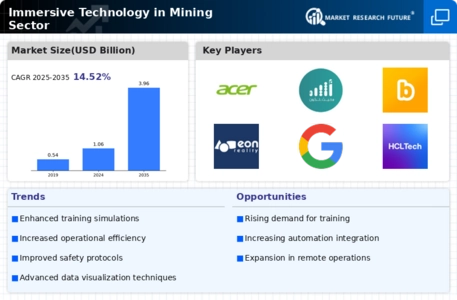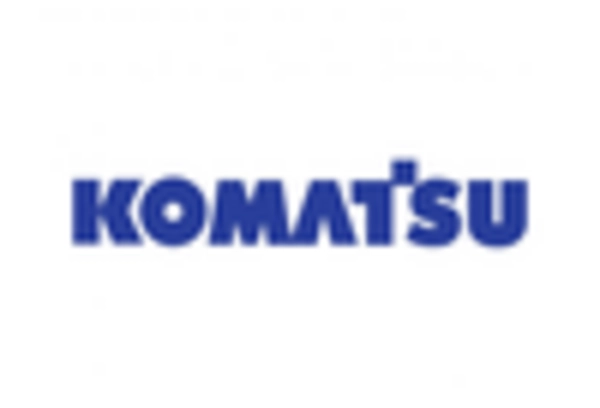-
EXECUTIVE SUMMARY
-
MARKET INTRODUCTION
-
Definition
-
Scope of the Study
- Research Objective
- Limitations
-
Assumptions
-
RESEARCH METHODOLOGY
-
Overview
-
Data Mining
-
Secondary Research
-
Primary Research
- Breakdown of Primary
-
Primary Interviews and Information Gathering Process
-
Respondents
-
Forecasting Modality
-
Market Size Estimation
- Bottom-Up Approach
- Top-Down Approach
-
Data Triangulation
-
Validation
-
MARKET DYNAMICS
-
Overview
-
Drivers
-
Restraints
-
Opportunities
-
MARKET FACTOR ANALYSIS
-
Value Chain Analysis
-
Porter’s Five Forces Analysis
- Bargaining
- Bargaining Power of Buyers
- Threat of
- Threat of Substitutes
- Intensity of Rivalry
-
Power of Suppliers
-
New Entrants
-
COVID-19 Impact Analysis
- Market Impact Analysis
- Opportunity and Threat Analysis
-
Regional Impact
-
GLOBAL IMMERSIVE
-
TECHNOLOGY IN MINING SECTOR, BY COMPONENT
-
Overview
-
Hardware
- Head-Mounted Display (HMD)
- Gesture Tracking Devices (GTD)
- Projectors & Display Walls (PDW)
-
Software/Platform
- Professional
- Managed
-
Services
-
GLOBAL IMMERSIVE TECHNOLOGY
-
IN MINING SECTOR, BY TECHNOLOGY
-
Overview
-
Mixed Reality (MR)
-
Virtual Reality (VR)
-
Augmented Reality (AR)
-
360 Film
-
GLOBAL IMMERSIVE TECHNOLOGY IN MINING SECTOR, BY APPLICATION
-
Overview
-
Training & Learning
-
Emergency Services
-
Product Development
-
Sales & Marketing
-
GLOBAL IMMERSIVE TECHNOLOGY IN MINING SECTOR,
-
BY REGION
-
Overview
-
North America
- U.S.
-
Canada
-
Europe
- Germany
- France
- U.K
- Italy
- Spain
- Rest of Europe
-
Asia-Pacific
- China
- India
- Japan
- South Korea
- Rest of Asia-Pacific
-
Australia
-
Rest of the World
- Africa
- Latin America
-
Middle East
-
COMPETITIVE LANDSCAPE
-
Overview
-
Competitive Analysis
-
Market Share Analysis
-
Major Growth Strategy in the Global IMMERSIVE TECHNOLOGY IN MINING SECTOR,
-
Competitive Benchmarking
-
Leading Players in Terms of Number of
-
Developments in the Global IMMERSIVE TECHNOLOGY IN MINING SECTOR,
-
Key
- New Component Launch/Type Application
- Merger & Acquisitions
- Joint Ventures
-
developments and Growth Strategies
-
Major
- Sales & Operating Income, 2022
-
Players Financial Matrix
-
Major Players R&D Expenditure. 2022
-
COMPANY PROFILES
-
ACER
- Company Overview
- Financial Overview
- Key Developments
- SWOT Analysis
-
INC.
-
Products Offered
-
Key Strategies
-
Atheer, Inc.
- Company Overview
- Products Offered
- Key Developments
- SWOT Analysis
- Key Strategies
-
Financial Overview
-
AVEVA Group PLC
- Company Overview
- Financial Overview
- Products
- Key Developments
- SWOT Analysis
- Key
-
Offered
-
Strategies
-
Barco NV
- Company Overview
- Financial
- Products Offered
- Key Developments
- Key Strategies
-
Overview
-
SWOT Analysis
-
Blippar Ltd.
- Company
- Financial Overview
- Products Offered
- SWOT Analysis
- Key Strategies
- Company Overview
- Financial Overview
- Key Developments
- SWOT Analysis
-
Overview
-
Key Developments
-
Carl Zeiss AG
-
Products Offered
-
Key Strategies
-
CM Labs Simulations Inc.
- Company Overview
- Financial Overview
- Products Offered
- Key Developments
- SWOT Analysis
- Key Strategies
-
EON Reality, Inc.
- Company Overview
- Financial Overview
- Products
- Key Developments
- SWOT Analysis
- Key
-
Offered
-
Strategies
-
FAAC Incorporated
- Company Overview
- Products Offered
- Key Developments
- SWOT Analysis
- Key Strategies
-
Financial Overview
-
Google, LLC
- Financial Overview
- Products Offered
- Key Developments
- SWOT Analysis
- Key Strategies
-
Company Overview
-
HCL Technologies Limited
- Company Overview
- Financial
- Products Offered
- Key Developments
- Key Strategies
-
Overview
-
SWOT Analysis
-
Honeywell International,
- Company Overview
- Financial Overview
- Key Developments
- SWOT Analysis
-
Inc.
-
Products Offered
-
Key Strategies
-
HTC Corporation
- Company Overview
- Products Offered
- Key Developments
- SWOT Analysis
- Key Strategies
-
Financial Overview
-
Immersive Media
- Company Overview
- Financial Overview
- Key Developments
- SWOT Analysis
-
Company
-
Products Offered
-
Key Strategies
-
Immersive Technologies Pty Limited
- Company
- Financial Overview
- Products Offered
- SWOT Analysis
- Key Strategies
- Company Overview
- Financial
- Products Offered
- Key Developments
- Key Strategies
-
Overview
-
Key Developments
-
Lockheed Martin Corporation
-
Overview
-
SWOT Analysis
-
Magic Leap, Inc.
- Financial Overview
- Products Offered
- Key Developments
- SWOT Analysis
- Key Strategies
-
Company Overview
-
NCTech Limited
- Company Overview
- Financial Overview
- Products Offered
- Key Developments
- SWOT Analysis
- Key Strategies
-
Oculus (Facebook Technologies, LLC.)
- Financial Overview
- Products Offered
- Key Developments
- SWOT Analysis
- Key Strategies
-
Company Overview
-
Samsung Group
- Company Overview
- Financial Overview
- Products Offered
- Key Developments
- SWOT Analysis
- Key Strategies
-
Sony Corporation
- Company Overview
- Financial Overview
- Products Offered
- Key Developments
- SWOT Analysis
- Key Strategies
-
Unity Software
- Company Overview
- Financial Overview
- Key Developments
- SWOT Analysis
-
Inc.
-
Products Offered
-
Key Strategies
-
Varjo Technologies Oy
- Company Overview
- Financial Overview
- Products Offered
- Key Developments
- SWOT Analysis
- Key Strategies
-
VI-grade GmbH
- Company Overview
- Financial Overview
- Products
- Key Developments
- SWOT Analysis
-
Offered
-
Key Strategies
-
Zeality Inc.
- Company Overview
- Products Offered
- Key Developments
- SWOT Analysis
- Key Strategies
-
Financial Overview
-
APPENDIX
-
References
-
Related Reports
-
-
LIST OF TABLES
-
TABLE
-
GLOBAL IMMERSIVE TECHNOLOGY IN MINING SECTOR, SYNOPSIS, 2018-2032
-
TABLE 2
-
GLOBAL IMMERSIVE TECHNOLOGY IN MINING SECTOR, ESTIMATES & FORECAST, 2018-2032
-
(USD BILLION)
-
GLOBAL IMMERSIVE TECHNOLOGY IN MINING SECTOR, BY COMPONENT,
-
GLOBAL IMMERSIVE TECHNOLOGY IN MINING SECTOR,
-
BY TYPE, 2018-2032 (USD BILLION)
-
GLOBAL IMMERSIVE TECHNOLOGY IN MINING
-
SECTOR, BY APPLICATION, 2018-2032 (USD BILLION)
-
NORTH AMERICA IMMERSIVE
-
TECHNOLOGY IN MINING SECTOR, BY COMPONENT, 2018-2032 (USD BILLION)
-
TABLE 7
-
NORTH AMERICA IMMERSIVE TECHNOLOGY IN MINING SECTOR, BY TYPE, 2018-2032 (USD BILLION)
-
NORTH AMERICA IMMERSIVE TECHNOLOGY IN MINING SECTOR, BY APPLICATION, 2018-2032
-
(USD BILLION)
-
NORTH AMERICA IMMERSIVE TECHNOLOGY IN MINING SECTOR,
-
BY COUNTRY, 2018-2032 (USD BILLION)
-
U.S. IMMERSIVE TECHNOLOGY IN MINING
-
SECTOR, BY COMPONENT, 2018-2032 (USD BILLION)
-
U.S. IMMERSIVE TECHNOLOGY
-
IN MINING SECTOR, BY TYPE, 2018-2032 (USD BILLION)
-
U.S. IMMERSIVE
-
TECHNOLOGY IN MINING SECTOR, BY APPLICATION, 2018-2032 (USD BILLION)
-
TABLE
-
CANADA IMMERSIVE TECHNOLOGY IN MINING SECTOR, BY COMPONENT, 2018-2032 (USD BILLION)
-
CANADA IMMERSIVE TECHNOLOGY IN MINING SECTOR, BY TYPE, 2018-2032 (USD
-
BILLION)
-
CANADA IMMERSIVE TECHNOLOGY IN MINING SECTOR, BY APPLICATION,
-
EUROPE IMMERSIVE TECHNOLOGY IN MINING SECTOR,
-
BY COMPONENT, 2018-2032 (USD BILLION)
-
EUROPE IMMERSIVE TECHNOLOGY
-
IN MINING SECTOR, BY TYPE, 2018-2032 (USD BILLION)
-
EUROPE IMMERSIVE
-
TECHNOLOGY IN MINING SECTOR, BY APPLICATION, 2018-2032 (USD BILLION)
-
TABLE
-
EUROPE IMMERSIVE TECHNOLOGY IN MINING SECTOR, BY COUNTRY, 2018-2032 (USD BILLION)
-
GERMANY IMMERSIVE TECHNOLOGY IN MINING SECTOR, BY COMPONENT, 2018-2032
-
(USD BILLION)
-
GERMANY IMMERSIVE TECHNOLOGY IN MINING SECTOR, BY TYPE,
-
GERMANY IMMERSIVE TECHNOLOGY IN MINING SECTOR,
-
BY APPLICATION, 2018-2032 (USD BILLION)
-
FRANCE IMMERSIVE TECHNOLOGY
-
IN MINING SECTOR, BY COMPONENT, 2018-2032 (USD BILLION)
-
FRANCE IMMERSIVE
-
TECHNOLOGY IN MINING SECTOR, BY TYPE, 2018-2032 (USD BILLION)
-
FRANCE
-
IMMERSIVE TECHNOLOGY IN MINING SECTOR, BY APPLICATION, 2018-2032 (USD BILLION)
-
ITALY IMMERSIVE TECHNOLOGY IN MINING SECTOR, BY COMPONENT, 2018-2032
-
(USD BILLION)
-
ITALY IMMERSIVE TECHNOLOGY IN MINING SECTOR, BY TYPE,
-
ITALY IMMERSIVE TECHNOLOGY IN MINING SECTOR,
-
BY APPLICATION, 2018-2032 (USD BILLION)
-
SPAIN IMMERSIVE TECHNOLOGY
-
IN MINING SECTOR, BY COMPONENT, 2018-2032 (USD BILLION)
-
SPAIN IMMERSIVE
-
TECHNOLOGY IN MINING SECTOR, BY TYPE, 2018-2032 (USD BILLION)
-
SPAIN
-
IMMERSIVE TECHNOLOGY IN MINING SECTOR, BY APPLICATION, 2018-2032 (USD BILLION)
-
U.K IMMERSIVE TECHNOLOGY IN MINING SECTOR, BY COMPONENT, 2018-2032 (USD
-
BILLION)
-
U.K IMMERSIVE TECHNOLOGY IN MINING SECTOR, BY TYPE, 2018-2032
-
(USD BILLION)
-
U.K IMMERSIVE TECHNOLOGY IN MINING SECTOR, BY APPLICATION,
-
REST OF EUROPE IMMERSIVE TECHNOLOGY IN MINING
-
SECTOR, BY COMPONENT, 2018-2032 (USD BILLION)
-
REST OF EUROPE IMMERSIVE
-
TECHNOLOGY IN MINING SECTOR, BY TYPE, 2018-2032 (USD BILLION)
-
REST
-
OF EUROPE IMMERSIVE TECHNOLOGY IN MINING SECTOR, BY APPLICATION, 2018-2032 (USD
-
BILLION)
-
ASIA PACIFIC IMMERSIVE TECHNOLOGY IN MINING SECTOR, BY COMPONENT,
-
ASIA PACIFIC IMMERSIVE TECHNOLOGY IN MINING
-
SECTOR, BY TYPE, 2018-2032 (USD BILLION)
-
ASIA PACIFIC IMMERSIVE TECHNOLOGY
-
IN MINING SECTOR, BY APPLICATION, 2018-2032 (USD BILLION)
-
ASIA PACIFIC
-
IMMERSIVE TECHNOLOGY IN MINING SECTOR, BY COUNTRY, 2018-2032 (USD BILLION)
-
TABLE
-
JAPAN IMMERSIVE TECHNOLOGY IN MINING SECTOR, BY COMPONENT, 2018-2032 (USD BILLION)
-
JAPAN IMMERSIVE TECHNOLOGY IN MINING SECTOR, BY TYPE, 2018-2032 (USD
-
BILLION)
-
JAPAN IMMERSIVE TECHNOLOGY IN MINING SECTOR, BY APPLICATION,
-
CHINA IMMERSIVE TECHNOLOGY IN MINING SECTOR,
-
BY COMPONENT, 2018-2032 (USD BILLION)
-
CHINA IMMERSIVE TECHNOLOGY IN
-
MINING SECTOR, BY TYPE, 2018-2032 (USD BILLION)
-
CHINA IMMERSIVE TECHNOLOGY
-
IN MINING SECTOR, BY APPLICATION, 2018-2032 (USD BILLION)
-
INDIA IMMERSIVE
-
TECHNOLOGY IN MINING SECTOR, BY COMPONENT, 2018-2032 (USD BILLION)
-
TABLE 49
-
INDIA IMMERSIVE TECHNOLOGY IN MINING SECTOR, BY TYPE, 2018-2032 (USD BILLION)
-
INDIA IMMERSIVE TECHNOLOGY IN MINING SECTOR, BY APPLICATION, 2018-2032
-
(USD BILLION)
-
AUSTRALIA IMMERSIVE TECHNOLOGY IN MINING SECTOR, BY
-
COMPONENT, 2018-2032 (USD BILLION)
-
AUSTRALIA IMMERSIVE TECHNOLOGY
-
IN MINING SECTOR, BY TYPE, 2018-2032 (USD BILLION)
-
AUSTRALIA IMMERSIVE
-
TECHNOLOGY IN MINING SECTOR, BY APPLICATION, 2018-2032 (USD BILLION)
-
TABLE
-
SOUTH KOREA IMMERSIVE TECHNOLOGY IN MINING SECTOR, BY COMPONENT, 2018-2032 (USD
-
BILLION)
-
SOUTH KOREA IMMERSIVE TECHNOLOGY IN MINING SECTOR, BY TYPE,
-
SOUTH KOREA IMMERSIVE TECHNOLOGY IN MINING
-
SECTOR, BY APPLICATION, 2018-2032 (USD BILLION)
-
REST OF ASIA-PACIFIC
-
IMMERSIVE TECHNOLOGY IN MINING SECTOR, BY COMPONENT, 2018-2032 (USD BILLION)
-
REST OF ASIA-PACIFIC IMMERSIVE TECHNOLOGY IN MINING SECTOR, BY TYPE,
-
REST OF ASIA-PACIFIC IMMERSIVE TECHNOLOGY
-
IN MINING SECTOR, BY APPLICATION, 2018-2032 (USD BILLION)
-
REST OF
-
WORLD IMMERSIVE TECHNOLOGY IN MINING SECTOR, BY COMPONENT, 2018-2032 (USD BILLION)
-
REST OF WORLD IMMERSIVE TECHNOLOGY IN MINING SECTOR, BY TYPE, 2018-2032
-
(USD BILLION)
-
REST OF WORLD IMMERSIVE TECHNOLOGY IN MINING SECTOR,
-
BY APPLICATION, 2018-2032 (USD BILLION)
-
REST OF WORLD IMMERSIVE TECHNOLOGY
-
IN MINING SECTOR, BY COUNTRY, 2018-2032 (USD BILLION)
-
MIDDLE EAST
-
IMMERSIVE TECHNOLOGY IN MINING SECTOR, BY COMPONENT, 2018-2032 (USD BILLION)
-
MIDDLE EAST IMMERSIVE TECHNOLOGY IN MINING SECTOR, BY TYPE, 2018-2032
-
(USD BILLION)
-
MIDDLE EAST IMMERSIVE TECHNOLOGY IN MINING SECTOR, BY
-
APPLICATION, 2018-2032 (USD BILLION)
-
AFRICA IMMERSIVE TECHNOLOGY IN
-
MINING SECTOR, BY COMPONENT, 2018-2032 (USD BILLION)
-
AFRICA IMMERSIVE
-
TECHNOLOGY IN MINING SECTOR, BY TYPE, 2018-2032 (USD BILLION)
-
AFRICA
-
IMMERSIVE TECHNOLOGY IN MINING SECTOR, BY APPLICATION, 2018-2032 (USD BILLION)
-
LATIN AMERICA IMMERSIVE TECHNOLOGY IN MINING SECTOR, BY COMPONENT, 2018-2032
-
(USD BILLION)
-
LATIN AMERICA IMMERSIVE TECHNOLOGY IN MINING SECTOR,
-
BY TYPE, 2018-2032 (USD BILLION)
-
LATIN AMERICA IMMERSIVE TECHNOLOGY
-
IN MINING SECTOR, BY APPLICATION, 2018-2032 (USD BILLION)
-
-
LIST
-
OF FIGURES
-
RESEARCH PROCESS
-
MARKET STRUCTURE FOR THE
-
GLOBAL IMMERSIVE TECHNOLOGY IN MINING SECTOR
-
MARKET DYNAMICS FOR THE
-
GLOBAL IMMERSIVE TECHNOLOGY IN MINING SECTOR
-
GLOBAL IMMERSIVE TECHNOLOGY
-
IN MINING SECTOR, SHARE (%), BY COMPONENT, 2022
-
GLOBAL IMMERSIVE TECHNOLOGY
-
IN MINING SECTOR, SHARE (%), BY TYPE, 2022
-
GLOBAL IMMERSIVE TECHNOLOGY
-
IN MINING SECTOR, SHARE (%), BY APPLICATION, 2022
-
GLOBAL IMMERSIVE
-
TECHNOLOGY IN MINING SECTOR, SHARE (%), BY REGION, 2022
-
NORTH AMERICA:
-
IMMERSIVE TECHNOLOGY IN MINING SECTOR, SHARE (%), BY REGION, 2022
-
FIGURE 9
-
EUROPE: IMMERSIVE TECHNOLOGY IN MINING SECTOR, SHARE (%), BY REGION, 2022
-
FIGURE
-
ASIA-PACIFIC: IMMERSIVE TECHNOLOGY IN MINING SECTOR, SHARE (%), BY REGION, 2022
-
REST OF THE WORLD: IMMERSIVE TECHNOLOGY IN MINING SECTOR, SHARE (%),
-
BY REGION, 2022
-
GLOBAL IMMERSIVE TECHNOLOGY IN MINING SECTOR: COMPANY
-
SHARE ANALYSIS, 2022 (%)
-
ACER INC. .: FINANCIAL OVERVIEW SNAPSHOT
-
ACER INC. :SWOT ANALYSIS
-
ATHEER, INC. .: FINANCIAL OVERVIEW
-
SNAPSHOT
-
ATHEER, INC. :SWOT ANALYSIS
-
AVEVA GROUP PLC.:
-
FINANCIAL OVERVIEW SNAPSHOT
-
AVEVA GROUP PLC:SWOT ANALYSIS
-
FIGURE
-
BARCO NV.: FINANCIAL OVERVIEW SNAPSHOT
-
BARCO NV:SWOT ANALYSIS
-
BLIPPAR LTD. .: FINANCIAL OVERVIEW SNAPSHOT
-
BLIPPAR LTD.
-
:SWOT ANALYSIS
-
CARL ZEISS AG.: FINANCIAL OVERVIEW SNAPSHOT
-
FIGURE
-
CARL ZEISS AG:SWOT ANALYSIS
-
CM LABS SIMULATIONS INC. .: FINANCIAL
-
OVERVIEW SNAPSHOT
-
CM LABS SIMULATIONS INC. :SWOT ANALYSIS
-
FIGURE
-
EON REALITY, INC. .: FINANCIAL OVERVIEW SNAPSHOT
-
EON REALITY,
-
INC. :SWOT ANALYSIS
-
FAAC INCORPORATED.: FINANCIAL OVERVIEW SNAPSHOT
-
FAAC INCORPORATED:SWOT ANALYSIS
-
GOOGLE, LLC.: FINANCIAL
-
OVERVIEW SNAPSHOT
-
GOOGLE, LLC:SWOT ANALYSIS
-
HCL TECHNOLOGIES
-
LIMITED.: FINANCIAL OVERVIEW SNAPSHOT
-
HCL TECHNOLOGIES LIMITED:SWOT
-
ANALYSIS
-
HONEYWELL INTERNATIONAL, INC. .: FINANCIAL OVERVIEW SNAPSHOT
-
HONEYWELL INTERNATIONAL, INC. :SWOT ANALYSIS
-
HTC CORPORATION.:
-
FINANCIAL OVERVIEW SNAPSHOT
-
HTC CORPORATION:SWOT ANALYSIS
-
FIGURE
-
IMMERSIVE MEDIA COMPANY.: FINANCIAL OVERVIEW SNAPSHOT
-
IMMERSIVE
-
MEDIA COMPANY:SWOT ANALYSIS
-
IMMERSIVE TECHNOLOGIES PTY LIMITED.:
-
FINANCIAL OVERVIEW SNAPSHOT
-
IMMERSIVE TECHNOLOGIES PTY LIMITED:SWOT
-
ANALYSIS
-
LOCKHEED MARTIN CORPORATION.: FINANCIAL OVERVIEW SNAPSHOT
-
LOCKHEED MARTIN CORPORATION:SWOT ANALYSIS
-
MAGIC LEAP,
-
INC. .: FINANCIAL OVERVIEW SNAPSHOT
-
MAGIC LEAP, INC. :SWOT ANALYSIS
-
NCTECH LIMITED.: FINANCIAL OVERVIEW SNAPSHOT
-
NCTECH LIMITED:SWOT
-
ANALYSIS
-
OCULUS (FACEBOOK TECHNOLOGIES, LLC..: FINANCIAL OVERVIEW
-
SNAPSHOT
-
OCULUS (FACEBOOK TECHNOLOGIES, LLC. :SWOT ANALYSIS
-
FIGURE
-
SAMSUNG GROUP.: FINANCIAL OVERVIEW SNAPSHOT
-
SAMSUNG GROUP:SWOT
-
ANALYSIS
-
SONY CORPORATION.: FINANCIAL OVERVIEW SNAPSHOT
-
FIGURE
-
SONY CORPORATION:SWOT ANALYSIS
-
UNITY SOFTWARE INC. .: FINANCIAL
-
OVERVIEW SNAPSHOT
-
UNITY SOFTWARE INC. :SWOT ANALYSIS
-
FIGURE
-
VARJO TECHNOLOGIES OY.: FINANCIAL OVERVIEW SNAPSHOT
-
VARJO TECHNOLOGIES
-
OY:SWOT ANALYSIS
-
VI-GRADE GMBH.: FINANCIAL OVERVIEW SNAPSHOT
-
FIGURE
-
VI-GRADE GMBH :SWOT ANALYSIS
-
ZEALITY INC. .: FINANCIAL OVERVIEW
-
SNAPSHOT
-
ZEALITY INC. SWOT ANALYSIS

















Leave a Comment